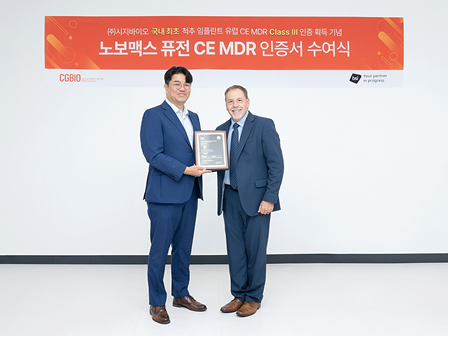CGBio said Thursday that its independently developed spinal implant, Novomax Fusion, has received certification under the European Union’s Medical Device Regulation (CE MDR), paving the way for sales in European markets.

The certification, issued after an official review by the British Standards Institution (BSI), marks the first time a Korean company has secured CE MDR approval in the spinal implant sector at the highest risk class, Class III. CGBio held a certificate handover ceremony with BSI to commemorate the achievement.
The MDR framework, which came into effect in May 2021, imposes stricter requirements than the previous Medical Device Directive (MDD), demanding more rigorous clinical evaluation, safety and efficacy validation, and quality management systems.
Class III products, which involve long-term implantation or direct life-sustaining functions, undergo the most stringent assessments, underscoring Novomax Fusion’s compliance with international standards.
Novomax Fusion is an anterior cervical cage designed for cervical fusion surgery in the C3–T1 region.
It replaces damaged discs, acting as a support structure that stabilizes and fuses the vertebrae. The implant incorporates CGBio’s proprietary bioactive glass-ceramic material, BGS-7.
Unlike titanium cages, which risk subsidence, or polyetheretherketone (PEEK) cages, which require additional bone grafting due to lack of direct bone bonding, Novomax Fusion achieves osteo-active fusion.
Studies showed its bonding strength with bone to be about 15 times higher than that of PEEK cages, enabling stable union without extra bone grafts.
The company’s technological edge has already been validated in Japan, one of the world’s most demanding medical device markets.
CGBio obtained product approval from Japan’s Pharmaceuticals and Medical Devices Agency (PMDA) in 2023 and this year signed a supply contract with Nihon Zoki Pharmaceutical and its subsidiary ZSpine, officially entering the Japanese market.
The latest EU certification signals accelerated global expansion, with Europe joining Japan as a key market.
CGBio said the MDR approval process involved a task force spanning its R&D and regulatory affairs divisions.
The team streamlined documentation, established a compliant quality system, and secured exemptions such as for post-market clinical follow-up (PMCF).
“Cross-department collaboration was the key to successfully completing the MDR transition review, which has also strengthened our regulatory response capacity,” CGBio Research Center Director Ryu Mi-young said.
CGBio CEO Yu Hyun-seung also said, “Novomax Fusion is a differentiated Korean spinal implant that promotes stable fusion without additional bone grafts thanks to our BGS-7 bioactive ceramic.”
Following Japan and now Europe, the company will actively drive entry into other advanced markets such as Australia, he added.
Yu also said that the CE MDR certification is being prepared for other flagship products such as Novosis, and that the company’s new Novo Factory, set to be completed in the second half of this year, will support rising global demand.
Related articles
- CGBio’s spinal implant Novomax Fusion enters Japanese market
- CGBio's Cellunit installed at Severance to treat knee osteoarthritis
- 16 doctors from Middle East join CGBio’s clinical training event in Seoul
- CGBio gets FDA nod to begin final U.S. trial for bone graft
- CGBio hosts international spine surgery training forum in Thailand
- CGBio scores MFDS approval for clinical trial of next-generation facial lifting thread

